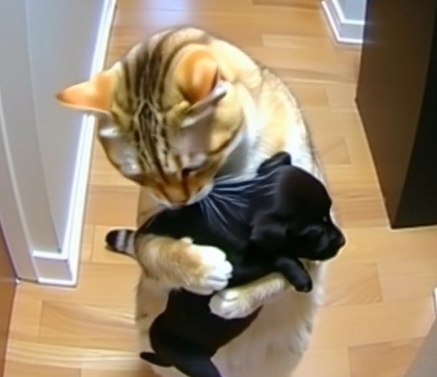A Prank Beyond Belief: When Friends Make You Think You’ve Attended Your Own Funeral
In the quiet suburbs of Cleveland, life often follows a predictable rhythm. People wave at neighbors, joggers pass by with their dogs, and routines carry on with comforting regularity. But one ordinary night, a group of friends decided to break that rhythm in the most extraordinary way.

What started as a typical evening of partying took a surreal turn when a man, having had one too many drinks, fell asleep on a couch.
Most friends might have let him sleep it off, perhaps nudging him with a blanket or quietly laughing at his slumber. But this group had a different idea: why not stage a prank so elaborate, so theatrical, that it would make their friend believe he had woken up at his own funeral?
The Setup: Turning an Ordinary Scene Into a Theatrical Stunt
Unlike small-scale pranks—like drawing on someone’s face with marker or hiding their shoes—this stunt required meticulous planning. The friends assembled props that mimicked a funeral scene: a coffin-like structure, dimmed lighting, carefully positioned decorations, and even mourners played by people in on the joke. Every detail was crafted to create the illusion of a solemn memorial service.
When the man awoke, he was met with a scene that would shock anyone: the familiar living room transformed into what appeared to be a space designed to commemorate his life. For a brief, disorienting moment, he seemed genuinely convinced he had somehow arrived at his own funeral.
The Moment of Shock and Realization
Video footage of the prank reveals a spectrum of emotions that captivated viewers. Initially, there is sheer confusion—wide eyes scanning the room, a slow, hesitant sit-up, and a palpable sense of disbelief. A moment later, panic begins to set in. But as the prank unfolds and laughter erupts from the friends around him, realization dawns. Relief and amusement replace fear, and the tension gives way to collective laughter.
This progression—from shock to clarity—is a hallmark of the most effective pranks. It is a carefully controlled emotional rollercoaster, and in this case, the stakes felt unusually high because the prank simulated a life-and-death scenario.
Why the Video Went Viral
Once shared online, the clip spread like wildfire across TikTok, Instagram, and Twitter. Audiences were drawn in by the combination of extreme surprise and the ultimate relief of the reveal. Psychologists explain that prank videos succeed because they elicit three intertwined emotional responses:
Surprise – Viewers are immediately drawn in by an unexpected event.
Tension – The scenario creates suspense or discomfort, triggering empathy for the “victim.”
Relief and amusement – The reveal resolves the tension, giving viewers a sense of emotional satisfaction.
In this prank, viewers experienced all three. The initial shock, coupled with curiosity about the man’s reaction, gave way to laughter once the truth was revealed—a formula perfectly suited for virality.
Public Reaction: Laughter, Admiration, and Ethical Debate
Reactions to the video were polarized, reflecting a larger conversation about the boundaries of humor in the digital age. Comments ranged from enthusiastic praise:
“Absolutely brilliant! I can’t stop watching his reaction!”
“This is the kind of creativity the internet needs more of.”
…to concern and critique:
“That’s way too extreme. He could’ve had a heart attack!”
“Pranks should never involve simulating death—it’s psychologically dangerous.”
The debate touches on a key ethical question: how far is too far when orchestrating a prank, especially one that plays on someone’s mortality? While the man in the video laughed afterward, the prank highlights the delicate balance between entertainment and emotional risk.
The Psychology of Extreme Pranks
Experts note that pranks often work because they manipulate expectations and disrupt normal reality. When executed with consent or understanding between participants, they can strengthen social bonds and create shared memories. But when boundaries are pushed, even momentarily, pranks can trigger stress responses, anxiety, or feelings of betrayal.
In this case, the friends’ confidence in their target’s temperament was crucial. Their trust that he would laugh rather than react with trauma enabled them to attempt a prank of unprecedented scale.
A Cultural Reflection: Why We Love Watching Pranks
Prank culture has evolved alongside social media. Where once jokes were private or limited to small circles, platforms now allow content to reach millions within hours. This transformation has fueled increasingly elaborate stunts, as creators vie for virality and attention.
Some iconic examples include:
Fake celebrity encounters – tricking friends into thinking they are meeting stars.
Room overhauls – filling bedrooms entirely with balloons, sticky notes, or unusual materials.
Vehicle transformations – covering cars in plastic wrap or aluminum foil.
The “funeral prank” stands out for its theatricality, emotional intensity, and sheer audacity. It’s not just a joke—it’s a performance, a mini production designed to provoke strong reactions from both the participant and the audience.
Lessons for Pranksters and Friends
This viral clip illustrates several key takeaways:
Know your audience – The success of an extreme prank depends on understanding the target’s personality and boundaries.
Plan carefully, but safely – Even the most creative ideas must account for emotional and physical well-being.
Trust is everything – A prank can only succeed if the target can ultimately laugh with the pranksters, not feel harmed.
Consider the digital afterlife – Once a video goes online, it’s accessible to millions and subject to scrutiny, so creators should anticipate public reactions.
The Internet Effect: Amplifying Humor and Discussion
What makes this prank particularly fascinating is how quickly it became a shared cultural moment. In the age of social media, private jokes are instantly global, sparking discussion about humor, boundaries, and the evolving ethics of digital content.
The clip serves as both entertainment and conversation starter, prompting debates about where the line lies between bold creativity and potential harm.
Conclusion: A Moment That Blurs Comedy and Shock
The “funeral prank” will be remembered not just for its audacity, but for how it captures the complexities of modern humor. It combined shock, theatricality, and eventual relief—a trifecta designed for virality.
While some questioned whether it went too far, the laughter that followed suggested that, at least for the participants, the stunt achieved its intended effect.
Ultimately, this viral moment reflects a larger truth: in an age where content spreads instantly, pranks are no longer small-scale jokes—they are performances that test creativity, friendship, and audience perception.
And as long as people chase humor online, pranks like this will continue to push the envelope, leaving viewers equally amazed, amused, and reflective.
It’s a lesson for pranksters everywhere: the best jokes are bold, unforgettable, and carefully balanced—never forgetting that the line between laughter and distress is thinner than it seems.



